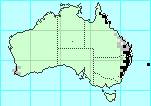“Body large and spinose, the male winged, female brachypterous; certain middle segments of the abdomen of both sexes with lateral tergal lobes, these much more expanded in female than in male. Head prognathous, dorsal apex conical and spinose; ocelli distinct in male, lacking or evanescent in female; antennae simple moderately pubescent. Mesothorax dilated posteriorly, less than twice prothoracic length. Tegmina of both sexes abbreviate, those of female somewhat broader than those of male; wings of male extending about to or beyond apex of abdomen, of female abbreviate, sometimes shriveled and rudimentary. Legs moderately long to short; femora and tibiae spinose, trigonate, broadly dilated, more markedly so in female; ventral surface of middle and hind tibiae without apical triangular area, bearing apical hooked spine; basitarsus somewhat shorter than remaining tarsal segments. Ovipositor sheath of female boat-shaped and extending posteriorly beyond apex of abdomen; ovipositor valves long, filamentous, apically curved.” (Gurney, 1947)
Taxonomy
The genus consists of two species.- Extatosoma tiaratum
There is only one species on the Australian mainland, with two recognised subspecies. - Extatosoma popa
This species does does not occur in Australia.
Identification Key
 Distribution
Distribution
The distribution map is a hot-linked
index. By clicking on a highlighted area of the map, you may obtain a
species list for that area, within this genus.
Extralimital distribution: New Guinea, see Kirby, W.F. (1904). A Synonymic Catalogue of Orthoptera. Vol. 1. Orthoptera, Euplexoptera, Cursoria, et Gressoria (Forficulidae, Hemimeridae, Blattidae, Mantidae, Phasmidae). London: Longmans & Co. x 501 pp. [381].
Brock, P.D. (2002). Studies on the Australasian stick-insect genus Extatosoma Gray (Phasmida: Phasmatidae: Tropoderinae: Extatosomatini), Journal of Orthoptera Research, Dec. 2001, 10(2): 303-313

